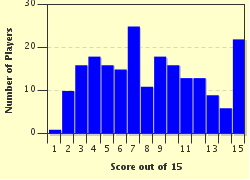Quiz Answer Key and Fun Facts
1. It has been shown that when two infinite sets are compared, one can be larger than the other. The set of real numbers is much larger than the set of integers. What theory says that there is no set larger than the set of integers and smaller than that of real numbers?
2. What constant is closely associated with perfection and shows up in the Pantheon, Art proportions, and nature as well as the Fibonacci sequence?
3. Fractals are shapes that are self similar at any scale and repeat indefinitely. Who is considered to be the father of fractal geometry?
4. Where did Fermat write down his 'Last Theorem'?
5. What was the first mathematical proof that required a computer program as part of the proof?
6. What well known mathematical shape, truly existing in four dimensions, yields a mobius strip when a section is taken through its middle?
7. What kind of curve is made by using a Spirograph?
8. What is the largest number that was given a name and practically used to solve a problem?
9. What statement simply says that if you have a collection of sets, there is a way to select one element from each set?
10. What theorem of mathematics seems to prove that if you take a mathematically perfect sphere apart, you can arrange it in such a way that you can put two spheres back together that are the same size as the original one?
11. "In a town of one barber who cuts the beards of men that don't cut their own beard, who cuts the barber's beard?". This is a generalization of which paradox?
12. What theory states that all formal systems will invariably have inconsistencies?
13. Which Millennium Problem describes the distribution of prime numbers in terms of complex numbers?
14. What shape uses numbers arranged in a pattern in order to demonstrate a correlation with prime numbers?
15. What is the highest honor rewarded in mathematics?
Source: Author
mitchcumstein
This quiz was reviewed by FunTrivia editor
rossian before going online.
Any errors found in FunTrivia content are routinely corrected through our feedback system.

